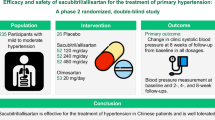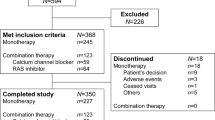Abstract
High dose (40 mg) olmesartan medoxomil (OM) blocks the angiotensin II receptor, significantly reducing blood pressure (BP). Adding hydrochlorothiazide (HCTZ) to OM increases efficacy, but has not been evaluated in patients inadequately controlled by OM 40 mg. Patients with grade 2 and grade 3 hypertension with inadequately controlled BP (seated diastolic blood pressure [SeDBP] 90–115 mm Hg and seated systolic blood pressure [SeSBP] 140–180 mm Hg, plus ambulatory BP criteria) after 8 weeks of OM 40 mg open-label treatment were randomized to 8 weeks of double-blind treatment with OM/HCTZ 40/25 (n=140), 40/12.5 (n=278), 20/12.5 mg (n=280) or OM 40 mg (n=274). Treatment with OM/HCTZ 40/25 mg and 40/12.5 mg significantly reduced SeDBP (−5.3 and −3.4 mm Hg, respectively), and SeSBP (−7.4 and −5.2 mm Hg, respectively), vs OM 40 mg monotherapy (P<0.0001 for each) in patients inadequately controlled on OM 40 mg alone. OM/HCTZ 40/12.5 mg reduced SeSBP significantly more than OM/HCTZ 20/12.5 mg (−2.6 mm Hg, P=0.0255), and also produced a further reduction in SeDBP vs the lower dose. All treatments were well tolerated, with similar low proportions of patients reporting treatment-emergent adverse events in all treatment groups. In conclusion, adding HCTZ to OM 40 mg significantly improves BP reductions and target BP rates in harder-to-treat patients and a clear dose-response was observed for efficacy.
This is a preview of subscription content, access via your institution
Access options
Subscribe to this journal
Receive 12 digital issues and online access to articles
$119.00 per year
only $9.92 per issue
Buy this article
- Purchase on Springer Link
- Instant access to full article PDF
Prices may be subject to local taxes which are calculated during checkout





Similar content being viewed by others
References
Lewington S, Clarke R, Qizilbash N, Peto R, Collins R . Age-specific relevance of usual blood pressure to vascular mortality: a meta-analysis of individual data for one million adults in 61 prospective studies. Lancet 2002; 360: 1903–1913.
Chobanian AV, Bakris GL, Black HR, Cushman WC, Green LA, Izzo Jr JL et al. The seventh report of the joint national committee on prevention, detection, evaluation, and treatment of high blood pressure: the JNC 7 report. JAMA 2003; 289: 2560–2572.
Mancia G, De Backer G, Dominiczak A, Cifkova R, Fagard R, Germano G et al. 2007 guidelines for the management of arterial hypertension: the task force for the management of arterial hypertension of the European Society of hypertension (ESH) and of the european society of cardiology (ESC). J Hypertens 2007; 25: 1105–1187.
Mancia G, Laurent S, Agabiti-Rosei E, Ambrosioni E, Burnier M, Caulfield MJ et al. Reappraisal of European guidelines on hypertension management: a European Society of hypertension task force document. J Hypertens 2009; 27: 2121–2158.
Pereira M, Lunet N, Azevedo A, Barros H . Differences in prevalence, awareness, treatment and control of hypertension between developing and developed countries. J Hypertens 2009; 27: 963–975 (online early section).
Bakris GL, Williams M, Dworkin L, Elliott WJ, Epstein M, Toto R et al. Preserving renal function in adults with hypertension and diabetes: a consensus approach. National kidney foundation hypertension and diabetes executive committees working group. Am J Kidney Dis 2000; 36: 646–661.
Fabia MJ, Abdilla N, Oltra R, Fernandez C, Redon J . Antihypertensive activity of angiotensin II AT1 receptor antagonists: a systematic review of studies with 24 h ambulatory blood pressure monitoring. J Hypertens 2007; 25: 1327–1336.
Maillard MP, Wurzner G, Nussberger J, Centeno C, Burnier M, Brunner HR . Comparative angiotensin II receptor blockade in healthy volunteers: the importance of dosing. Clin Pharmacol Ther 2002; 71: 68–76.
Hasler C, Nussberger J, Maillard M, Forclaz A, Brunner HR, Burnier M . Sustained 24-h blockade of the renin-angiotensin system: a high dose of a long-acting blocker is as effective as a lower dose combined with an angiotensin-converting enzyme inhibitor. Clin Pharmacol Ther 2005; 78: 501–507.
Jones MR, Sealey JE, Laragh JH . Effects of angiotensin receptor blockers on ambulatory plasma Renin activity in healthy, normal subjects during unrestricted sodium intake. Am J Hypertens 2007; 20: 907–916.
Sellin L, Stegbauer J, Laeis P, Rump LC . Adding hydrochlorothiazide to olmesartan dose dependently improves 24-h blood pressure and response rates in mild-to-moderate hypertension. J Hypertens 2005; 23: 2083–2092.
Mancia G, Grassi G . Systolic and diastolic blood pressure control in antihypertensive drug trials. J Hypertens 2002; 20: 1461–1464.
Coltamai L, Maillard M, Simon A, Vogt B, Burnier M . Comparative vascular and renal tubular effects of angiotensin II receptor blockers combined with a thiazide diuretic in humans. J Hypertens 2010; 28: 520–526.
Le MT, Pugsley MK, Vauquelin G, Van Liefde I . Molecular characterisation of the interactions between olmesartan and telmisartan and the human angiotensin II AT1 receptor. Br J Pharmacol 2007; 151: 952–962.
Brunner HR, Stumpe KO, Januszewicz A . Antihypertensive efficacy of olmesartan medoxomil and candesartan cilexetil assessed by 24-h ambulatory blood pressure monitoring in patients with essential hypertension. Clin Drug Invest 2003; 23: 419–430.
Oparil S, Williams D, Chrysant SG, Marbury TC, Neutel J . Comparative efficacy of olmesartan, losartan, valsartan, and irbesartan in the control of essential hypertension. J Clin Hypertens (Greenwich) 2001; 3: 283–291–318.
Nakayama S, Watada H, Mita T, Ikeda F, Shimizu T, Uchino H et al. Comparison of effects of olmesartan and telmisartan on blood pressure and metabolic parameters in Japanese early-stage type-2 diabetics with hypertension. Hypertens Res 2008; 31: 7–13.
Pickering TG . When and how to use self (home) and ambulatory blood pressure monitoring. J Am Soc Hypertens 2008; 2: 119–124.
Staessen JA, Thijs L, Fagard R, O'Brien ET, Clement D, de Leeuw PW et al. Predicting cardiovascular risk using conventional vs ambulatory blood pressure in older patients with systolic hypertension. Systolic hypertension in Europe trial Investigators. JAMA 1999; 282: 539–546.
Sega R, Facchetti R, Bombelli M, Cesana G, Corrao G, Grassi G et al. Prognostic value of ambulatory and home blood pressures compared with office blood pressure in the general population: follow-up results from the Pressioni Arteriose Monitorate e Loro Associazioni (PAMELA) study. Circulation 2005; 111: 1777–1783.
White WB . Circadian variation of blood pressure: clinical relevance and implications for cardiovascular chronotherapeutics. Blood Press Monit 1997; 2: 47–51.
Turnbull F . Effects of different blood-pressure-lowering regimens on major cardiovascular events: results of prospectively-designed overviews of randomised trials. Lancet 2003; 362: 1527–1535.
Sawada T, Yamada H, Dahlof B, Matsubara H . Effects of valsartan on morbidity and mortality in uncontrolled hypertensive patients with high cardiovascular risks: KYOTO HEART Study. Eur Heart J 2009; 30: 2461–2469.
Schrader J, Luders S, Kulschewski A, Hammersen F, Plate K, Berger J et al. Morbidity and mortality after stroke, eprosartan compared with nitrendipine for secondary prevention: principal results of a prospective randomized controlled study (MOSES). Stroke 2005; 36: 1218–1226.
Volpe M, Tocci G, Sciarretta S, Verdecchia P, Trimarco B, Mancia G . Angiotensin II receptor blockers and myocardial infarction: an updated analysis of randomized clinical trials. J Hypertens 2009; 27: 941–946.
Yusuf S, Teo KK, Pogue J, Dyal L, Copland I, Schumacher H et al. Telmisartan, ramipril, or both in patients at high risk for vascular events. N Engl J Med 2008; 358: 1547–1559.
Elliott WJ, Meyer PM . Incident diabetes in clinical trials of antihypertensive drugs: a network meta-analysis. Lancet 2007; 369: 201–207.
Burnier M, Brunner HR . Angiotensin II receptor antagonists. Lancet 2000; 355: 637–645.
Acknowledgements
The authors gratefully acknowledge the efforts of all of the investigators who participated in this study. This study was sponsored by Daiichi Sankyo Europe GmbH. We also thank Dr Phil Jones of in Science Communications who provided medical writing support funded by Daiichi Sankyo Europe GmbH.
Author information
Authors and Affiliations
Corresponding author
Ethics declarations
Competing interests
LCR has received honoraria from Daiichi Sankyo for talks and consultancy.
XG, in the past 3 years has been paid speakers's fees or travel costs by BMS, Boehringer Ingelheim, Daiichi Sankyo, Ipsen, Novartis, Pfizer, Sanofi Aventis and Takeda. XG has been paid consulting fees by Novartis, Daiichi Sankyo and Boehringer Ingelheim.
LS: no conflicts of interest.
JS: no conflicts of interest.
Rights and permissions
About this article
Cite this article
Rump, L., Girerd, X., Sellin, L. et al. Effects of high dose olmesartan medoxomil plus hydrochlorothiazide on blood pressure control in patients with grade 2 and grade 3 hypertension. J Hum Hypertens 25, 565–574 (2011). https://doi.org/10.1038/jhh.2010.105
Received:
Revised:
Accepted:
Published:
Issue Date:
DOI: https://doi.org/10.1038/jhh.2010.105
Keywords
This article is cited by
-
Monotherapy and Dual Combination Therapies Based on Olmesartan: A Comprehensive Strategy to Improve Blood Pressure Control
High Blood Pressure & Cardiovascular Prevention (2017)
-
Olmesartan medoxomil: a guide to its use as monotherapy or in fixed-dose combinations with amlodipine and/or hydrochlorothiazide
Drugs & Therapy Perspectives (2016)
-
Efficacy and Safety of Triple Antihypertensive Therapy with the Olmesartan/Amlodipine/Hydrochlorothiazide Combination
Clinical Drug Investigation (2012)
-
How do Compliance, Convenience, and Tolerability Affect Blood Pressure Goal Rates?
American Journal of Cardiovascular Drugs (2012)



